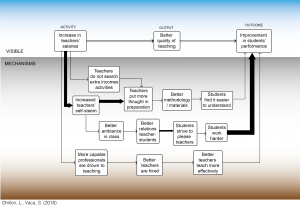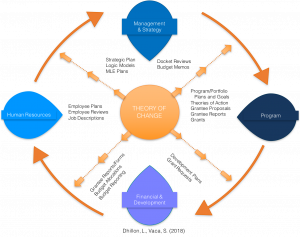Hi, I am Sara Vaca (Independent Evaluator and Saturday’s contributor to this blog), and today I am sharing part of the work Lovely Dhillon (Jodevi Consulting) and I have been doing on regarding Theories of Change. Since Theories of Change (ToCs) are having a lot of attention lately, we wanted to share our learning and work on how to make better use of them.
Cool Trick: First, it is good to define the Elements with which your theory is going to be built. Initially Strategies, Results (Outputs and Outcomes), Impact and basic Causal Links are key parts of it. Ideally, Mechanisms, Assumptions and more refined Causal Links should be present too, and, optionally, Inputs, Bottlenecks, Risks, Context among others can be considered.

In other words, in our view: if you want your logic to be called a Theory of Change instead of a Logic Model, you need to include Mechanisms and explain the logic of how the activities will lead to the results without major leaps!
Hot Tip: There are visual features that can be used to make the Mechanisms, usually simplified by arrows, more transparent. For example, making them thick and allowing content inside them like this:

Also, placing the “visible” part of the project on top (such as Activities, Results and Impact), and the “less visible” parts as in the example below is another possibility:

Lessons Learned: When developing a Theory of Change, there are many dimensions that need to be considered. The ideal level for each dimension will depend on the purpose of each Theory of Change and its context (e.g., scope, complexity, timing, participants).
Without attempting to be too prescriptive, there are some characteristics that are generally more desirable than others in a strong Theory of Change.
This is the spectrum we built based on a rubric:

We understand “strong” Theories of Change to include those which have a smaller probability of theory failure, i.e. when the intervention was poorly conceived and didn’t work in practice (Patton, 2015).
Also, a Theory of Change is strong when we anticipate that the result of the sequence of activities can logically be expected to lead to program success (Alkin, 2011).
Cool Trick: Not all organizations have a ToC, but it is all too rare to see the ones that have it linked to other organizational tools, such as Strategic Plans, Monitoring and Evaluation Plans, Grant Proposals and Reports, Budget Documents, Job Descriptions, and Job Reviews, among others. The outcomes articulated in the organizational Theory of Change should be central and inform the other organizational tools.

Rad Resource: The Journal of MultiDisciplinary Evaluation just published our paper “Refining Theories of Change” gathering all these ideas and visuals, and more!
References:
Alkin, M. (2011). Evaluation essentials: From A to Z. New York, NY: The Guilford Press.
Patton, M.Q. (2015). Qualitative research and evaluation methods: Integrating theory and practice (4th ed.). Los Angeles, CA: Sage.
Do you have questions, concerns, kudos, or content to extend this aea365 contribution? Please add them in the comments section for this post on the aea365 webpage so that we may enrich our community of practice. Would you like to submit an aea365 Tip? Please send a note of interest to aea365@eval.org . aea365 is sponsored by the American Evaluation Association and provides a Tip-a-Day by and for evaluators.

Pingback: My Chosen Program and its Context – PME 802: Program Inquiry and Evaluation
Hello Sara and Lovely,
I am currently taking a graduate course in program evaluation and have found your visuals very helpful to my understanding. I particularly benefited from the Mechanisms below the surface graphic. What stood out to me was the connection to the line above “if you want your logic to be called a Theory of Change instead of a Logic Model, you need to include Mechanisms and explain the logic of how the activities will lead to the results without major leaps!” (As an educator I want to share this with my own students with regards to their work, “guide me along your thinking and don’t make any major leaps in your explanation!”)
I appreciated the comparison between the visual activity and output versus the less visible mechanisms “below the surface”. This was a thoughtful example as it showed multiple effects for one activity, all with the same outcome. I wonder if you have ever experienced contradicting effects in a Theory of Change when examining the below the surface mechanisms. Something to the effect of, if we do X, then Y will be affected positively because…, but also Y will be affected negatively because… It would be interesting to explore and balance the positive and negative effects the mechanisms in a Theory of Change.
Thank you so much for sharing these great visuals.
Michelle
Sara and Lovely what a great post. I love the idea of including mechanisms within the logic model – something I will incorporate into my own practice. Look forward to reading more in your paper!
Thanks, Jenny! :-)))